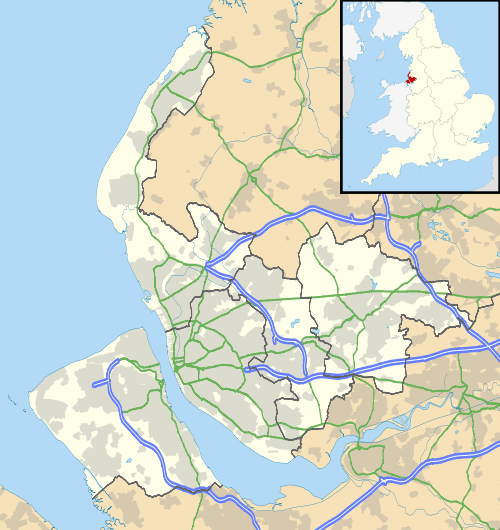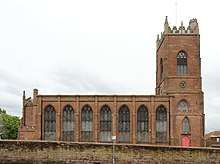Everton, Liverpool
Everton is a district in Liverpool, in Merseyside, England, in the Liverpool City Council ward of Everton. It is part of the Liverpool Walton Parliamentary constituency. Historically in Lancashire, at the 2001 Census the population was recorded as 7,398,[1] increasing to 14,782 at the 2011 Census.[2]
| Everton | |
|---|---|
Everton Brow, with Everton Lock-Up visible | |
 Everton Location within Merseyside | |
| Population | 14,782 (2011 Census) |
| OS grid reference | SJ358917 |
| Metropolitan borough | |
| Metropolitan county | |
| Region | |
| Country | England |
| Sovereign state | United Kingdom |
| Post town | LIVERPOOL |
| Postcode district | L3, L5, L6 |
| Dialling code | 0151 |
| Police | Merseyside |
| Fire | Merseyside |
| Ambulance | North West |
| UK Parliament | |
Toponymy
The name Everton is derived from the Saxon word eofor, meaning wild boar that lives in forests.[3]
Description
Everton is an inner-city area located just north of Liverpool city centre, with Vauxhall to the west, Kirkdale to the north, and Anfield to the north-east. The Liverpool entrance to the Kingsway Tunnel is located near the boundaries of this area. Everton consists generally of more modern terraced homes, and is statistically one of the most deprived areas of the city.
History
Everton is an ancient settlement and, like Liverpool, was one of the six unnamed berewicks of West Derby. Until the late 18th century Everton was a small rural parish of Walton-on-the-Hill, but the rise in wealth of nearby Liverpool pushed its wealthier merchants towards Everton and further afield to live. By the early 19th century Liverpool's demand for housing saw Everton begin to be built up; Everton became part of Liverpool in 1835.[4] Much of the land in Everton was once owned by the local Hodson family.
Along with neighbouring Vauxhall, Everton housed a very large Irish population. Sectarianism was one negative consequence of religious differences with tensions between Catholics and Protestants existing well into the 20th century. St Domingo Road in Everton was the intended site for the building of the Metropolitan Cathedral, but this was abandoned owing to financial constraints. The cathedral was eventually located in the city centre near to the southern edge of Everton.[5]
Urban clearance during the 1960s and 1970s, followed by the creation of Everton Park, changed the face of the area and some parts have never recovered. The population has plummeted by over 100,000 since the 1960s; Everton Park has replaced the densely packed streets with fields and trees. The landscape of Everton is now mainly non-urban with the loss of so many people and many hundreds of buildings.


'Project Jennifer'[6] is a scheme to breathe new life into rundown parts of Everton centred on Great Homer Street including a revamped 'Greaty' market. However the project has suffered numerous delays and setbacks. The NSPCC Hargreaves Centre (named after locally born benefactor John Hargreaves) was opened in May 2007 on the site of the former indoor market.
Notable residents
- William Connolly (VC), soldier
- Thomas de Quincey, 19th century author
- Bill Dean, Liverpool actor
- Gordon Elliot, Australian journalist and talk-show host
- William Gawin Herdman, author and painter
- Paul Aloysius Kenna, cavalry officer and VC recipient
- Paul McCartney, musician
- George Mahon (Everton F.C. chairman), an Everton F.C. founding father
- Prince Rupert of the Rhine, soldier
- Robert Tressell, author
- Robb Wilton, English comedian and actor
The book Her Benny by Silas Hocking was mainly set in Everton and dealt with child poverty in the early 1900s.
Landmarks
- Everton Lock-Up
- Everton Road drill hall, TA Centre used by the 9th Kings during the Second Boer War and the First World War
- Everton water tower, listed building
- St George's Church, Everton
- Everton Library
Everton F.C. connection
The football club Everton F.C. (originally called St. Domingo F.C.) is named after the area (St. Domingo Methodist Chapel was in Everton). The district is also the location of a building on the club's crest, Everton Lock-Up, known locally as Prince Rupert's Tower. Barker and Dobson, a local sweet manufacturer, introduced 'Everton Mints' to honour Everton Football Club.
Ironically, Everton F.C. has never actually played in the area. Its first three homes were located in Anfield, including Stanley Park; the club has played at Goodison Park in the area of Walton since 1892. In addition, Everton Cemetery is also not located in Everton, it lies further north-east in the district of Fazakerley.
Liverpool F.C. connection
The football club Liverpool F.C. was originally founded as 'Everton Football Club and Athletic Ground Company, Ltd', or 'Everton Athletic', on 26 January 1892, as a consequence of the Everton F.C. split that resulted in Everton F.C.'s move to Goodison Park in 1892. The former Evertonians who founded 'Everton Athletic' to play at Anfield renamed the club 'Liverpool F.C.' on 3 June 1892.[7]
Schools
- Beacon Church of England Primary
- Campion Catholic High School (demolished 2006)
- Notre Dame Catholic College
- Our Lady Immaculate Catholic Primary
- Whitefield Primary School
References
- 2001 Census: Everton, Office for National Statistics, retrieved 12 January 2009
- "City of Liverpool ward population 2011". Retrieved 12 January 2016.
- Everton's Origins, Toffee Web, archived from the original on 3 June 2007, retrieved 6 June 2007
- Liverpool: Our City, Our Heritage by Freddy O'Connor
- "History of the Metropolitan Cathedral". Liverpool Metropolitan Cathedral. Archived from the original on 29 January 2009. Retrieved 4 July 2009.
- Project Jennifer, Liverpool City Council, archived from the original on 8 November 2007, retrieved 16 February 2008
- Everton Athletic
External links
| Wikimedia Commons has media related to Everton, Liverpool. |
- Liverpool City Council, Ward Profile: Everton
- Liverpool Record Office Online Catalogue for Everton
- Liverpool Street Gallery - Liverpool 3
- Liverpool Street Gallery - Liverpool 5
- Liverpool Street Gallery - Liverpool 6
- Evening images from Everton Brow
- photo of Congregational chapel, Netherfield Road, Everton
